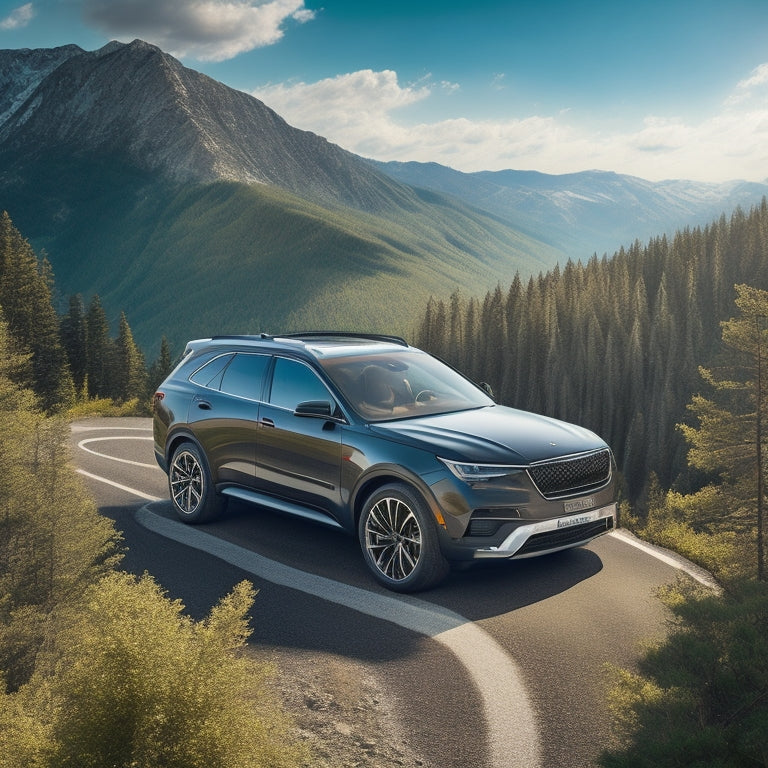
Install Solar Panels on Your Vehicle for Less
Share
To install solar panels on your vehicle for less, start by evaluating your vehicle's solar potential, taking into account available surface area and obstacles. Choose the right solar panels with high efficiency ratings and necessary certifications. Confirm that your vehicle's electrical system can handle the added power requirements and consider DIY installation or professional help. Take advantage of government-backed incentives and explore rebates and tax credits to reduce costs. By following these steps, you'll be on your way to harnessing renewable energy on the go while keeping costs in check - and there's more to explore to get the best value for your money.
Key Takeaways
• Assess your vehicle's solar potential by evaluating available surface area, obstacles, and energy waste to determine the best installation plan.
• Choose affordable solar panels with high efficiency ratings (around 20% or higher) and ensure they meet safety and performance standards.
• Take advantage of government-backed solar incentives, rebates, and tax credits to reduce installation costs.
• Consider DIY installation if you have basic electrical and mechanical skills, but weigh the benefits of professional installation for complex installations.
• Explore affordable solar panel options, as the cost of solar panels has decreased over the years due to technological advancements.
Assessing Your Vehicle's Solar Potential
Determine your vehicle's solar potential by evaluating its available surface area, taking into account obstacles like roof racks, antennas, or other features that may limit panel placement. This will give you a clear idea of how much energy you can harness from the sun.
To get started, create a Vehicle Profile, noting the make, model, and year of your ride. Measure the length, width, and any obstacles on the roof, hood, and trunk. You'll also want to contemplate the type of solar panels you plan to install and their energy output.
Next, perform an Energy Audit to identify areas where energy is being wasted. Check for air leaks, inefficient accessories, and other energy-sucking culprits. This will help you optimize your vehicle's energy efficiency and maximize the benefits of going solar.
Choosing the Right Solar Panels
With your vehicle's solar potential assessed, you're now ready to select the ideal solar panels that will efficiently harness the sun's energy and meet your vehicle's specific power needs. It's time to get panel-picky!
When choosing the right solar panels, you'll want to take into account efficiency ratings, which indicate how well the panels convert sunlight into electricity. Look for panels with high efficiency ratings (around 20% or higher) to maximize energy production.
Don't forget to check for panel certifications, such as UL (Underwriters Laboratories) or IEC (International Electrotechnical Commission) certifications, which guarantee the panels meet safety and performance standards.
You'll also want to take into consideration the panel's durability, weight, and flexibility, as these factors will impact the installation process and overall performance.
Understanding Installation Requirements
As you prepare to install solar panels on your vehicle, you need to understand the installation requirements that guarantee a safe and efficient system.
You'll need to assess your vehicle's electrical system to determine its capacity to support the added power source, select solar panels that meet your energy needs, and plan the mounting and wiring of the panels to guarantee a secure and reliable connection.
Vehicle Electrical System
You'll need to evaluate your vehicle's electrical system to confirm it can handle the added power requirements of the solar panel installation. Think of it as checking if your vehicle's electrical infrastructure is ready for a solar-powered upgrade.
To do this, you'll need to explore electric circuit analysis, which might sound intimidating, but trust us, it's worth it. You'll need to identify the maximum power output of your solar panels and make sure your vehicle's electrical system can handle the increased load.
Grab your wiring diagram and get ready to interpret it like a pro! You'll need to analyze the diagram to identify the correct wiring routes, fuse ratings, and circuit breaker capacities. This will help you determine if your vehicle's electrical system can handle the added power requirements.
Don't worry, it's not as complicated as it sounds. With a little patience and attention to detail, you'll be ready to install those solar panels in no time. Remember, a thorough understanding of your vehicle's electrical system is essential to a successful installation. So, take your time, and let's get started!
Solar Panel Selection
Selecting the right solar panel for your vehicle installation demands a thorough understanding of your energy needs and the installation requirements that will guarantee a safe and efficient system. Don't fall for solar myths - you need to take into account the actual power requirements of your vehicle's electrical system.
Calculate your energy needs based on your appliances, lights, and other devices. This will help you determine the suitable wattage and voltage for your solar panel.
When choosing a solar panel, aesthetics matter too. You want a panel that complements your vehicle's design while providing the necessary power. Look for panels with a sleek design, durable materials, and a waterproof coating to withstand the outdoor elements. Take into consideration the size and weight of the panel, ensuring it won't compromise your vehicle's performance or fuel efficiency.
Lastly, make sure the solar panel is compatible with your vehicle's electrical system and meets the necessary safety standards. By doing your research and selecting the right solar panel, you'll be well on your way to a successful installation that meets your energy needs and enhances your vehicle's functionality.
Mounting and Wiring
With your solar panel selected, it's time to focus on mounting and wiring it securely to your vehicle, ensuring a reliable and efficient energy harvesting system. Now, you're probably thinking, 'How do I attach this panel to my ride without compromising its integrity?' Rest assured, friend, for we've your back.
When it comes to mounting considerations, you'll want to make sure your solar panel is securely fastened to your vehicle's roof or hood. Here are some key points to keep in mind:
-
Roof rack integration: If you've got a roof rack, consider integrating your solar panel into the existing framework to minimize additional weight and wind resistance.
-
Hood-mounted options: If you prefer a hood-mounted setup, choose a system that allows for adjustable angles to maximize energy harvesting.
-
Wind tunnel testing: Consider simulating wind tunnel conditions to ensure your mounting system can withstand harsh weather conditions.
- Vibration dampening: Don't forget to incorporate vibration dampening materials to minimize panel wear and tear.
DIY Installation Vs Professional Help
When considering solar panel installation on your vehicle, deciding between a DIY approach and hiring a professional is an important step that can greatly impact the project's success. As you weigh the pros and cons, consider your time constraints and skill levels.
| DIY | Professional |
|---|---|
| Time: You'll need to dedicate several hours to research, planning, and installation. | Time: A professional will handle the installation, saving you time and hassle. |
| Skill level: You'll need basic electrical and mechanical skills to guarantee a safe and efficient installation. | Skill level: A professional has the expertise to manage complex installations and ensure a high-quality job. |
| Cost: You'll need to purchase the necessary tools and materials, which can add up quickly. | Cost: While hiring a professional may seem expensive upfront, they'll have the necessary tools and materials. |
| Warranty: You'll be responsible for any mistakes or defects in the installation. | Warranty: A professional will typically offer a warranty on their work, giving you peace of mind. |
| Liability: You'll be liable for any accidents or damages during the installation process. | Liability: A professional will have insurance to cover any accidents or damages. |
Ultimately, if you have the time, skills, and patience, a DIY installation might be a cost-effective option. However, if you're short on time or lack confidence in your abilities, hiring a professional is the way to go.
Affordable Solar Panel Options
You'll find that affordable solar panel options are now more accessible than ever, thanks to advancements in technology and increasing demand. As you explore your options, you'll discover that the cost of solar panels has decreased greatly over the years, making it more feasible to install them on your vehicle.
Here are some affordable solar panel options to explore:
-
Government-backed Solar Incentives: Take advantage of federal and state incentives that offer rebates and tax credits for solar panel installations.
-
Energy Cooperatives: Join local energy cooperatives that pool resources to purchase solar panels at discounted rates.
-
Second-hand Solar Panels: Consider purchasing refurbished or used solar panels at a lower cost.
- DIY Solar Panel Kits: Opt for DIY solar panel kits that include everything you need to install solar panels on your vehicle, often at a lower cost than hiring a professional.
Maximizing Energy Harvesting Efficiency
By strategically positioning and angling your solar panels, you can greatly enhance energy harvesting efficiency, thereby maximizing your vehicle's solar power output. It's all about finding the sweet spot where energy optimization meets angular tolerance.
Think of it like finding the perfect sun-kissed spot on a beach - you want to soak up as much energy as possible!
To achieve this, consider the orientation of your vehicle and the path of the sun. For instance, if you're driving southbound during peak sun hours, angle your panels to face the sun directly. Remember, every degree counts! A slight adjustment can make a significant difference in energy production.
Don't be afraid to experiment and fine-tune your setup to optimize energy harvesting. With a little patience and practice, you'll be harnessing the power of the sun like a pro!
Overcoming Installation Challenges
Solar panel installation on your vehicle can be a complex process, requiring careful planning and problem-solving to overcome unique challenges, such as limited roof space, aerodynamic considerations, and electrical system integration. You'll need to think creatively to guarantee a successful installation.
To overcome these challenges, consider the following strategies:
-
Structural Reinforcement: Reinforce your vehicle's roof to support the added weight of the solar panels. This may involve adding structural beams or brackets to distribute the weight evenly.
-
Weather Sealing: Guarantee a watertight seal around the solar panels to prevent water ingress and electrical shorts. Use high-quality sealants and gaskets to achieve a reliable seal.
-
Custom Mounting Solutions: Design custom mounting solutions to accommodate your vehicle's unique shape and size. This may involve 3D printing or fabricating custom brackets.
- Electrical System Integration: Guarantee seamless integration with your vehicle's electrical system. This may involve consulting with an electrician or using pre-made electrical integration kits.
Balancing Cost and Quality
As you consider installing solar panels on your vehicle, you're likely weighing the importance of quality against the constraints of cost.
You'll need to decide whether to prioritize top-tier materials and design or opt for more affordable options that might compromise on performance.
Quality Over Cost
What're you willing to compromise on: a higher upfront cost for superior quality or a lower price tag with potentially inferior performance? When it comes to installing solar panels on your vehicle, the answer to this question can make all the difference.
While it may be tempting to opt for the cheaper option, keep in mind that you get what you pay for. A higher-quality solar panel system may come with a higher price tag, but it will also provide you with:
-
Brand reputation: A well-established brand with a reputation for producing high-quality products
-
Premium materials: Durable materials that can withstand the elements and last longer
-
Efficient energy conversion: Higher efficiency rates for maximum energy output
- Warranty and support: Thorough warranty and dedicated customer support in case something goes wrong
Material Durability Matters
When you're investing in a solar panel system for your vehicle, you'll want to balance the cost with the quality of materials, because the durability of those materials directly impacts the system's performance and lifespan. You don't want to skimp on quality and end up with a system that can't withstand the elements.
Importance is paramount, especially if you plan to take your vehicle off-grid or drive in harsh climates. Look for materials that have been tested for UV resistance, water resistance, and extreme temperature fluctuations.
Material science plays a significant role in solar panel durability. The type of glass or polymer used, for instance, can affect the system's ability to withstand weathering. You'll want to opt for materials that have been engineered to minimize degradation over time.
A high-quality system may cost more upfront, but it'll pay for itself in the long run with improved performance and a longer lifespan. By prioritizing material durability, you'll guarantee your solar panel system remains efficient and effective for years to come.
Balance in Design
By carefully weighing the trade-offs between cost and quality, you can achieve a solar panel system that meets your vehicle's unique energy needs without breaking the bank. It's all about finding that sweet spot where functionality meets aesthetics.
A well-designed system shouldn't only provide the necessary power but also complement your vehicle's sleek design.
Here are some key considerations to keep in mind:
-
Aesthetic considerations: Guarantee the solar panels blend seamlessly with your vehicle's contours, maintaining a smooth visual flow. You don't want bulky panels ruining the sleek lines of your ride!
-
Visual flow: Strategically place panels to minimize visual obstructions, ensuring an uncluttered appearance that doesn't distract from the overall design.
-
Material selection: Balance durability with cost by selecting materials that provide the necessary strength without overspending.
- System integration: Assure a seamless integration of the solar panel system with your vehicle's electrical system, avoiding any awkward add-ons or clunky components.
Incentives for Vehicle Solar Adoption
You can greatly reduce the cost of installing solar panels on your vehicle through federal and state incentives, which offer attractive rebates and tax credits. These perks can shave off a significant chunk of the upfront cost, making solar-powered transportation more accessible.
The federal government, for instance, offers a 30% tax credit for qualified solar panel installations, which can be claimed on your tax return. Additionally, many states offer their own incentives, such as rebates, grants, or exemptions from sales taxes. These government subsidies can help offset the initial investment, making solar panels a more viable option for your vehicle.
Long-Term Maintenance and Care
As you enjoy the benefits of solar power on your vehicle, remember that regular maintenance is important to guarantee peak performance.
You'll need to establish a cleaning schedule to remove dirt and debris that can reduce energy output, and regularly monitor your panel's performance to identify any potential issues.
Regular Cleaning Schedules
Regular cleaning schedules are crucial to maintaining your vehicle's solar panels, as dirt and debris can greatly reduce their energy output over time. You'll want to keep those panels squeaky clean to guarantee maximum energy harvesting. A dirty panel is an inefficient panel, and who wants that?
To keep your solar panels in top shape, follow these cleaning tips:
-
Clean your solar panels at least every 2-3 months, or more often if you live in a dusty or polluted area.
-
Use a soft-bristled brush or a microfiber cloth to gently sweep away dirt and debris.
-
Mix a solution of mild soap and water, and use a soft-bristled brush to gently scrub the panels. Rinse thoroughly with water to prevent streaks and spots.
- Avoid using harsh chemicals or abrasive materials that can scratch or damage your panels.
Panel Performance Monitoring
Every 6-12 months, perform a thorough inspection of your vehicle's solar panel system to guarantee maximum energy harvesting and detect potential issues before they escalate. You don't want to be stuck with a system that's not performing at its best, do you? During this inspection, keep an eye out for loose connections, damaged panels, and dirty surfaces. A clean and well-maintained system is essential for peak energy production.
To take your panel performance monitoring to the next level, invest in a data analytics system that provides real-time energy tracking. This will give you a clear picture of your energy production, allowing you to identify areas for improvement and make data-driven decisions.
By monitoring your energy output, you can detect potential issues before they become major problems, saving you time and money in the long run. With energy tracking, you'll be able to optimize your system's performance, ensuring you're getting the most value for your investment.
Frequently Asked Questions
Can I Install Solar Panels on a Leased Vehicle?
Before installing solar panels, you'll need to check your lease agreement for any modifications restrictions. Also, review your insurance coverage to confirm it'll still be valid with the added panels.
Will Solar Panels Affect My Vehicle's Warranty?
When adding solar panels, you'll want to secure manufacturer approval to avoid warranty voidance; check your contract, as unauthorized mods can nullify it, leaving you high and dry (and solar-less)!
Can I Use Solar Panels to Charge My Electric Bike?
'You can harness the sun's power to charge your e-bike with portable solar panels, a fantastic eco-friendly bike accessory. Just verify that the panels' output matches your bike's voltage and amp requirements for a smooth ride.'
Do Solar Panels Work During Cloudy or Rainy Days?
On cloudy or rainy days, you'll still harvest some energy, but expect reduced Cloudy Performance. Solar panels' energy harvesting capabilities are impaired, yet they'll still generate some power - just not as efficiently as on sunny days.
Are Solar Panels Durable Enough for Off-Road Adventures?
You put your solar panels through rugged testing, and they'll withstand harsh environments, but don't worry, they're built tough, so you can tackle off-road adventures without worrying about your panels getting damaged.
Related Posts
-

Why Choose Affordable Electric Scooters for Urban Commuting
By choosing an affordable electric scooter for urban commuting, you'll not only reduce your transportation costs by u...
-

Find Your Eco-Friendly Motorcycle for a Sustainable Ride
You're shifting gears towards a more sustainable ride, opting for an eco-friendly motorcycle that combines thrill wit...
-

Sustainable Commuting: Top Daily Use Electric Bicycles
You're looking to trade in your gas-guzzling vehicle for a more sustainable option, and a daily use electric bicycle ...


